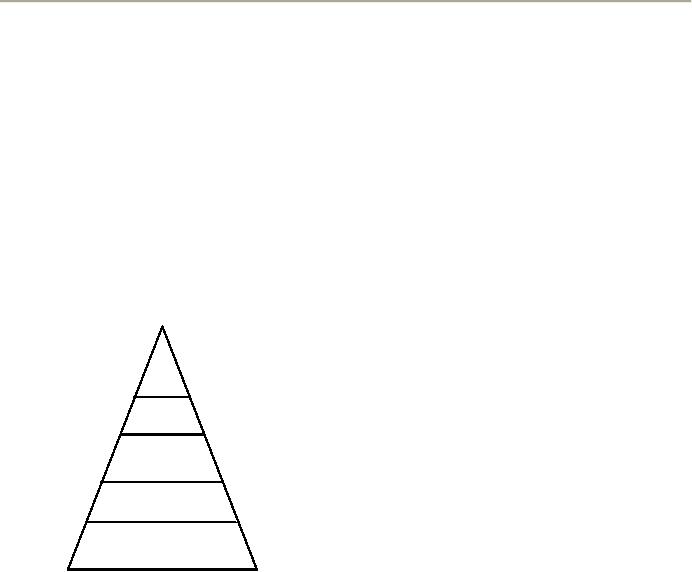 |

Abnormal
Psychology PSY404
VU
LESSON
5
PSYCHOPATHOLOGY
IN HISTORICAL CONTEXT
PSYCHOLOGICAL
MODEL
Humanistic
Model
Humanistic
view puts the emphasis on the
positive aspects of life,
free choices and personal
growth
experiences.
Abnormality results from
refusal to accept personal responsibility
for one's own actions
and
thoughts.
So human behavior is caused by the
choices we make voluntarily.
The Humanistics assume
that
human
nature is inherently good
and they blame abnormal / aggressive
behavior caused by the society
but
not
by the individual.
Abraham
Maslow (1908-1970)
postulated a hierarchy of needs beginning
with physiological needs at the
bottom
and self actualization at the top. An
individual must meet the
basic needs before trying to
meet the
higher
needs.
Self
Actualization
Self
Esteem
Love
and Belongingness
Safety
Needs
Psychological
Needs
Maslow's
Hierarchy of needs
The
triangle or pyramid has a broad base and
narrow top, so majority of individuals
are involved at
fulfilling
basic
needs and only few
reach the top i.e. self
actualization means that we can
reach our highest
potential
in
all areas of functioning if we
had freedom to grow. Majority of the
people are involved in fulfilling
the
needs
at the lower level and it is very few who
reach the top e.g. Quaid-e-Azam, Dr
Abdul Salam.
Carl
Rogers (1902-1987)
originated the client centered therapy, later
known as person centered
approach.
The
therapist takes a passive position
and provides the client and
environment to develop insight about the
self
consists of all the perceptions,
ideas and values that
characterize "I" "Me" i.e. what I am and
what I can
do.
The
main constructs of the theory
are unconditional positive
regard and empathy. Unconditional
positive
regard
being given the sense that they are
valued by parents and others
even when they are less
than ideal or
perfect.
Empathy
is understanding the of client's world
from client's frame of
reference or putting, yourself in
the
client's
shoe and trying to
understand his problem how
he perceives it.
23

Abnormal
Psychology PSY404
VU
Behavioral
Model / Cognitive-Behavioral / social
learning model
Behavioral
model emphasizes that behavior
patterns (both normal and
abnormal) are learned from
the
environment.
The three forms of learning associated
with psychological disorders
are
1.
Classical
Conditioning
2.
Operant
Conditioning
3.
Observational
learning/Modeling.
Classical
Conditioning
It
is a basic form of learning, discovered
by a Russian physiologist Ivan Pavlov
(1849-1936). Pavlov
and
associates
were investigating salivation process in
dogs. They gave meat powder
and the dog salivate
it.
The
Classical Conditioning process
involves following
terms
UCS
→ Unconditioned
stimulus
UCR
→Unconditioned
response
CS
→ Conditioned
stimulus
CR
→ Conditioned
response
The
dogs salivated as the researchers
were about to provide meat
power, soon after the dogs
salivated at the
sight
of the researchers and also to the
sound of their
footsteps
Meat
powder → salivation
UCS
UCR
Sight
of researchers
→
Salivation
Footsteps
of researcher
CS
CR
Now
learning comes in form of any
association with any person
or object. This is unconditioned
stimulus.
In
this case sight of the researchers or the
footsteps of the researchers acquires the
power to elicit the same
response
so now footsteps or sight of
researchers is the conditioned stimulus
leading to conditioned
response.
Extinction
CS
→
CR
Now
conditioned stimulus does
lead to conditioned response.
This is extinction. That is the
footsteps of the
researchers
or their sight did not
lead to salivation. In another classic
study by Watson (1878-1958) an
11
months
old boy Little Albert
acquired a conditioned fear. Albert
was introduced to a white
rat, he showed
no
fear to it. When Albert
tried to reach the white
rat, a loud noise was
produced which startled little
Albert.
This
process was repeated for a
number of trials, so little Albert learnt
to be afraid of white rat or
through
classical
conditioning; Little Albert
acquired the fear or Phobia of white
rat.
White
rate
+
loud
noise →
Fear
NS
Paired
UCS
UCR
The
neutral stimulus was white rat
paired with unconditioned
stimulus loud noise leading
to fear response
in
little Albert. After a number of
trials, the neutral stimulus took the
status of conditioned stimulus
and
evoked
the conditioned response that is
fear.
White
rat
→
Fear
CS
CR
24

Abnormal
Psychology PSY404
VU
Stimulus
Generalization
Little
Albert became afraid of all
white furry animals, toys,
so this is called stimulus generalization
i.e. the
response
generalizes to all similar
objects. Watson's Student
Mary Cover Jones (1896-1987)
thought that if
fear
could be learned or acquired or
classically conditioned perhaps it could
be un-learned/extinction can
take
place. She worked with a
boy Peter, who was
three years old, who
were already afraid of white
rabbits.
Jones
decided to bring white
rabbit in to the room where
peter was playing for a short time
each day. She
also
arranged for other children
whom she knew did not
fear rabbits. Jones noted
that gradually Peter's
fear
decreased
and diminished and soon
Peter was touching and
playing with rabbits.
Extinction
is when the bond between conditioned
stimulus with conditioned
response is weaken or
broken.
CS
→
CR
In
this case white rabbit does
not elicit fear response. So
the bond between the CS and CR is
broken.
Parents
in our culture create a lot of
fear in children, when little
children are crying. Parents
often say, a jin
will
come out of the dark and get
you. So our parents condition
children to be phobic of dark.
Operant
Conditioning
The
term operant conditioning was coined by Skinner
(1904-1990) behavior operates on the
environment
and
changes in some way. The
reinforcement or reward affects the
behavior.
When
responses lead to satisfying
consequences, the responses are
strengthen and likely to
occur in future.
1.
When
positive consequences follow a
behavior, the behavior is rewarded
and more likely to
occur
in future. Maladaptive and
desirable behavior alike can be
acquired through
their
consequences.
When a child screams in the
store for a toy, she
gets her way because
the
parents
want her to be quiet. The child
learns that screaming
produces rewards.
2.
When
an unwanted behavior leads to negative
outcome, the likely hood
that the unwanted
behavior
will occur in future is
reduced. When an alcohol addict is given
some irritating agent
in
his drink which causes
vomiting and swatting, he
learns to give up drinking alcohol or
when
misbehaving
student is corrected in front of the
class, the probability of misbehavior to
reoccur
in
future is reduced. Punishment
can have desirable outcomes
but harsh and cruel
and
consistent
punishments are detrimental.
Shaping,
a
process of reinforcing successive
approximations to a final behavior take
an example of a
mentally
retarded child. How he has
to learn to fill water in
his glass and the whole
task is broken down
in
to
small steps, such as
1.
Holding the glass.
2.
Filling it with water from
the jug.
3.
Sufficient level of the water in the
glass.
4.
Putting the jug back on the
table.
5.
Taking the glass to the level of the
mouth.
6.
Taking a sip of water
without spilling it.
7.
As the learner masters each
steps of the whole task is reinforced
and the whole shaping
process
may take a week for the
mentally retarded child.
Observational
Learning or Modeling
Stanford
university professor, Albert Bandura,
pioneered the analysis of observational learning or
modeling
which
is process of learning behavior by observing
others. It is learning through imitation.
Aggressive
behavior
can be learned by observing others.
Adult models punched and
abused "a bobo doll"
while
25

Abnormal
Psychology PSY404
VU
children
watched and were later
permitted to play with the same
doll and children imitated
aggressive
behaviors
as observed.
Social
learning theory by Bandura purposes,
that behavior is the product of
both external stimulus
events
and
internal cognitive
process.
Cognitive
model
Cognitive
model is concerned with human
cognition how human beings
perceive recognize, attend,
reason
and
judge. This model
includes:
1.
Rational Emotive Behavior Therapy. (REBT)
(Albert Ellis) 1962
2.
Cognitive Theory Of Depression
(Aaron Beck - 1967)
1.
Rational Emotive Behavior
Therapy. (REBT) (Albert
Ellis) 1962
According
to Albert Ellis, maladaptive
behavior results when people
operate on misguided and
inaccurate
assumptions.
Ellis catalogued 11 irrational
believes responsible for
maladaptive behavior. The
ABC of
rational
emotive behavior therapy is where:
A
Activating event
B
Belief System
C
Emotional behavioral
consequences.
A
→
C
Activating
Emotional
Behavioral
Event
consequences
A
→
B
→
C
Activating
events
Filter
through one's
Belief
system
A
→
B
→
C
Irrational
beliefs
Activating
event A can cause unwanted emotional and
behavioral consequences when filter
through
beliefs
that are irrational.
2.
Cognitive Theory of Depression.
For
Beck, depressed people possess a
negative cognitive
triad.
About
themselves
Deprived,
defeated diseased.
Depressed
individual
the
world which is
and
negative cognitions
full
of road blocks
Future
which is devoid of hope
Beck
says depressed individual see
themselves as defeated, deprived and
diseased and their world as
full of
road
blocks and their future
without hope.
Summary
The
models discussed were
1.
Supernatural
Model
2.
Biological
Model
3.
Psychological
Model
26
Abnormal
Psychology PSY404
VU
4.
Humanistic
Model
5.
Behavioral
Model
6.
Cognitive
Model
7.
Cognitive
theory of depression.
In
today's world psychologists
study abnormal behavior not
with reference to one single
model rather they
adopt
the integrative approach which respond to
all aspects of abnormal
behavior.
27
Table of Contents:
- ABNORMAL PSYCHOLOGY:PSYCHOSIS, Team approach in psychology
- WHAT IS ABNORMAL BEHAVIOR:Dysfunction, Distress, Danger
- PSYCHOPATHOLOGY IN HISTORICAL CONTEXT:Supernatural Model, Biological Model
- PSYCHOPATHOLOGY IN HISTORICAL CONTEXT:Free association, Dream analysis
- PSYCHOPATHOLOGY IN HISTORICAL CONTEXT:Humanistic Model, Classical Conditioning
- RESEARCH METHODS:To Read Research, To Evaluate Research, To increase marketability
- RESEARCH DESIGNS:Types of Variables, Confounding variables or extraneous
- EXPERIMENTAL REASEARCH DESIGNS:Control Groups, Placebo Control Groups
- GENETICS:Adoption Studies, Twin Studies, Sequential Design, Follow back studies
- RESEARCH ETHICS:Approval for the research project, Risk, Consent
- CAUSES OF ABNORMAL BEHAVIOR:Biological Dimensions
- THE STRUCTURE OF BRAIN:Peripheral Nervous System, Psychoanalytic Model
- CAUSES OF PSYCHOPATHOLOGY:Biomedical Model, Humanistic model
- CAUSES OF ABNORMAL BEHAVIOR ETIOLOGICAL FACTORS OF ABNORMALITY
- CLASSIFICATION AND ASSESSMENT:Reliability, Test retest, Split Half
- DIAGNOSING PSYCHOLOGICAL DISORDERS:The categorical approach, Prototypical approach
- EVALUATING SYSTEMS:Basic Issues in Assessment, Interviews
- ASSESSMENT of PERSONALITY:Advantages of MMPI-2, Intelligence Tests
- ASSESSMENT of PERSONALITY (2):Neuropsychological Tests, Biofeedback
- PSYCHOTHERAPY:Global Therapies, Individual therapy, Brief Historical Perspective
- PSYCHOTHERAPY:Problem based therapies, Gestalt therapy, Behavioral therapies
- PSYCHOTHERAPY:Ego Analysis, Psychodynamic Psychotherapy, Aversion Therapy
- PSYCHOTHERAPY:Humanistic Psychotherapy, Client-Centered Therapy, Gestalt therapy
- ANXIETY DISORDERS:THEORIES ABOUT ANXIETY DISORDERS
- ANXIETY DISORDERS:Social Phobias, Agoraphobia, Treating Phobias
- MOOD DISORDERS:Emotional Symptoms, Cognitive Symptoms, Bipolar Disorders
- MOOD DISORDERS:DIAGNOSIS, Further Descriptions and Subtypes, Social Factors
- SUICIDE:PRECIPITATING FACTORS IN SUICIDE, VIEWS ON SUICIDE
- STRESS:Stress as a Life Event, Coping, Optimism, Health Behavior
- STRESS:Psychophysiological Responses to Stress, Health Behavior
- ACUTE AND POSTTRAUMATIC STRESS DISORDERS
- DISSOCIATIVE AND SOMATOFORM DISORDERS:DISSOCIATIVE DISORDERS
- DISSOCIATIVE and SOMATOFORM DISORDERS:SOMATOFORM DISORDERS
- PERSONALITY DISORDERS:Causes of Personality Disorders, Motive
- PERSONALITY DISORDERS:Paranoid Personality, Schizoid Personality, The Diagnosis
- ALCOHOLISM AND SUBSTANCE RELATED DISORDERS:Poly Drug Use
- ALCOHOLISM AND SUBSTANCE RELATED DISORDERS:Integrated Systems
- SCHIZOPHRENIA:Prodromal Phase, Residual Phase, Negative symptoms
- SCHIZOPHRENIA:Related Psychotic Disorders, Causes of Schizophrenia
- DEMENTIA DELIRIUM AND AMNESTIC DISORDERS:DELIRIUM, Causes of Delirium
- DEMENTIA DELIRIUM AND AMNESTIC DISORDERS:Amnesia
- MENTAL RETARDATION AND DEVELOPMENTAL DISORDERS
- MENTAL RETARDATION AND DEVELOPMENTAL DISORDERS
- PSYCHOLOGICAL PROBLEMS OF CHILDHOOD:Kinds of Internalizing Disorders
- LIFE CYCLE TRANSITIONS AND ADULT DEVELOPMENT:Aging